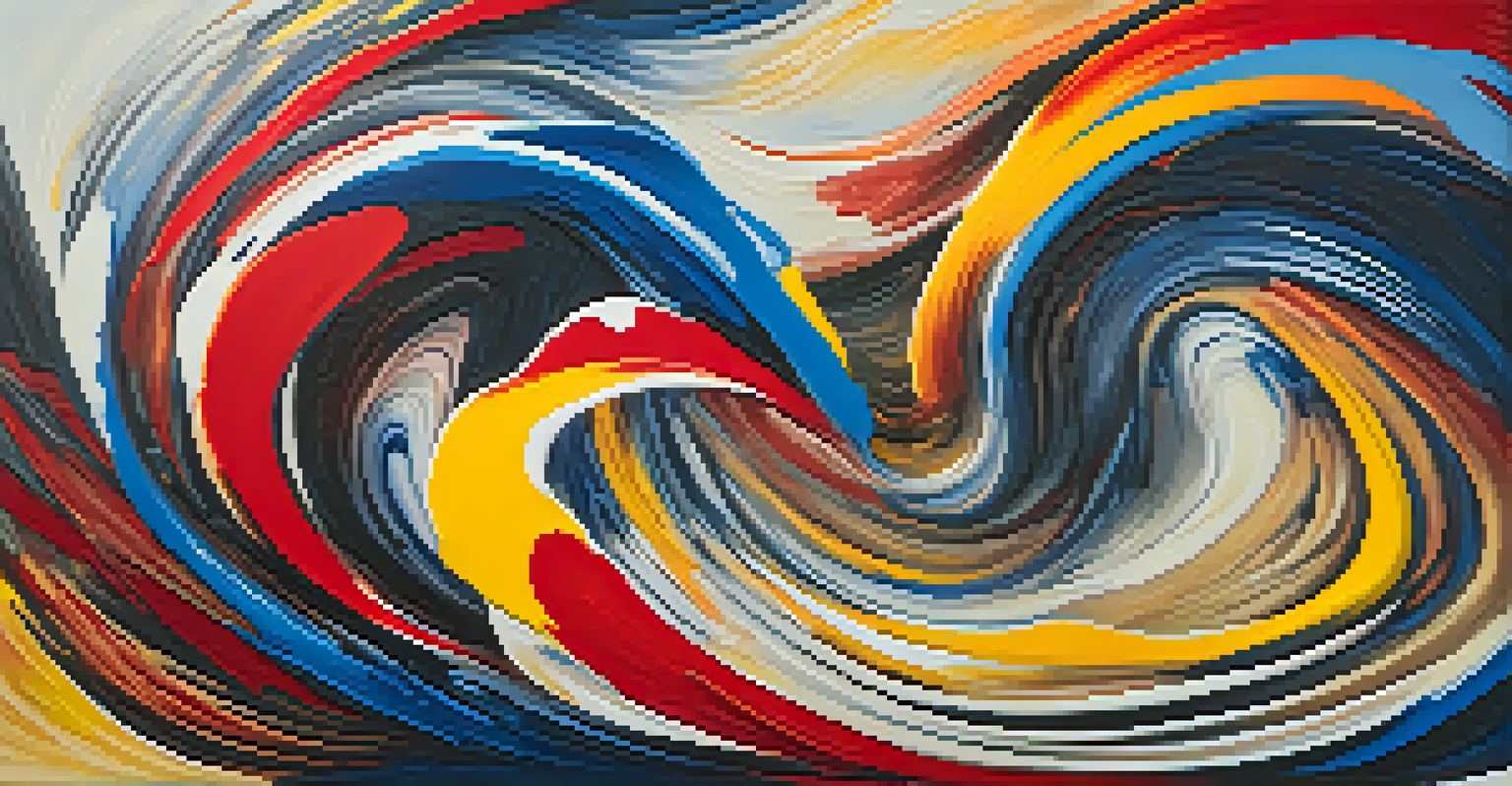Cultural Contexts: Emotions Reflected in Artistic Styles

Understanding the Link Between Emotions and Art
Art is often seen as a reflection of emotions, capturing the essence of human experience. When artists create, they draw upon their feelings, experiences, and cultural backgrounds, which shape the final piece. This connection between emotions and art can be observed across various forms and styles, from painting to music and literature.
Every artist dips his brush in his own soul, and paints his own nature into his pictures.
For instance, the somber tones of a melancholic painting can evoke feelings of sadness, while vibrant colors in a lively mural can inspire joy and excitement. Artists harness these emotions to convey messages and provoke thought, making art a powerful medium for communication. The emotional undertones present in artistic works can often reveal deeper cultural narratives that resonate with audiences.
As we delve deeper into different cultures, we start to notice how specific emotions are expressed uniquely through their artistic styles. From the serene landscapes of Eastern art to the bold strokes of Western abstract expressionism, the emotional landscape painted by artists always carries cultural significance.
Cultural Influences on Artistic Expression
Every culture has its own set of values, beliefs, and traditions that influence artistic expression. These cultural contexts can dictate how emotions are perceived, interpreted, and portrayed through art. For example, in many Indigenous cultures, art is not just an aesthetic endeavor; it is a means of storytelling and preserving history.

In contrast, contemporary Western art often emphasizes individualism, allowing artists to channel personal emotions directly into their work. This divergence highlights how cultural backgrounds shape not only the content of art but also the techniques and styles employed. The emotional weight behind a piece can often be traced back to the cultural narratives that inform it.
Emotions Shape Artistic Expression
Artists draw upon their emotions and cultural backgrounds to create works that reflect human experience and provoke thought.
Thus, understanding these cultural influences provides a richer context for interpreting art. By recognizing the interplay between emotions and cultural backgrounds, viewers can appreciate the nuances that make each piece unique.
Historical Perspectives on Emotion in Art
Throughout history, different art movements have emerged, each reflecting the emotional climate of their time. The Romantic movement, for instance, sought to express intense emotions and a connection to nature, reacting against the rationalism of the Enlightenment. Artists like Turner and Delacroix infused their works with passion and a sense of the sublime, showcasing the emotional depth often associated with the period.
Art is the most beautiful of all lies; it is a lie that reveals the truth.
Similarly, the Expressionist movement aimed to convey raw emotion, often distorting reality to express the artist's feelings. Artists like Edvard Munch, famous for 'The Scream,' exemplified how art could be a vessel for deep-seated anxiety and existential dread. These historical perspectives reveal how artists have always been in tune with the emotional currents of their eras.
By examining these art movements, we gain insight into how societal shifts inform artistic expression. The emotional landscapes of history are vividly captured in the works of those who lived through them, providing a lens through which we can understand past cultures.
Contemporary Art and Emotional Expression
In contemporary art, the exploration of emotions has taken on new forms, often blurring the boundaries between personal and collective experiences. Artists today frequently tackle themes of identity, trauma, and mental health, using their platforms to foster dialogue around these deeply emotional issues. This shift reflects a growing societal awareness of mental health and the importance of emotional well-being.
For example, installations that invite audience participation can create a shared emotional experience, allowing viewers to engage with the art on a personal level. This interactive approach breaks down traditional barriers between artist and audience, emphasizing that emotion is a communal experience. As a result, contemporary art becomes not just a reflection of individual feelings but a mirror for collective emotions.
Cultural Context Influences Art
Cultural values and traditions play a significant role in how emotions are interpreted and expressed in art across different societies.
Moreover, the rise of social media has allowed artists to share their work and emotional narratives with a broader audience. This accessibility fosters a global conversation about emotions, transcending cultural barriers and connecting individuals from diverse backgrounds.
The Role of Color in Emotional Expression
Color plays a crucial role in conveying emotions within artistic styles, often serving as a visual language that transcends words. Different colors evoke distinct feelings; for example, blue may induce calmness or sadness, while red can evoke passion or anger. Artists consciously choose colors to enhance the emotional impact of their work, making their intentions clear.
Consider the iconic 'Starry Night' by Vincent van Gogh, where swirling blues and yellows create a sense of turbulence and longing. The emotional resonance of the color palette complements the themes of isolation and hope present in the painting. This relationship between color and emotion highlights how artists manipulate visual elements to communicate complex feelings.
Understanding the psychological effects of color can deepen our appreciation of art. As viewers, recognizing how colors influence our emotional responses allows us to engage more thoughtfully with the artwork and the emotions it seeks to express.
Symbolism in Art and Emotional Depth
Symbolism is another powerful tool artists use to convey emotions, often layering meaning beneath the surface of their work. Specific symbols can evoke intricate feelings, connected to cultural or historical contexts. For instance, a broken chain may symbolize freedom from oppression, while a wilting flower can signify lost love or fading beauty.
By incorporating symbols, artists can communicate complex emotions without explicitly stating them. This subtlety invites viewers to engage with the artwork on a deeper level, encouraging personal interpretation and emotional connection. The richness of symbolism adds another layer of depth to artistic expression, making it an essential element in understanding the emotional landscape of a piece.
Symbolism Deepens Emotional Impact
Through symbolism, artists convey complex emotions, allowing for personal interpretation and a deeper connection with their work.
Furthermore, symbols can transcend cultural boundaries, allowing for a universal exploration of emotions. While interpretations may vary, the emotional core remains relatable, illustrating the shared human experience through art.
The Future of Emotion in Artistic Contexts
As we look toward the future, the exploration of emotions in artistic contexts continues to evolve. With advancements in technology, artists are experimenting with new mediums to express feelings in innovative ways. Virtual reality, for instance, allows for immersive experiences that can evoke strong emotional responses, pushing the boundaries of traditional art forms.
Moreover, the growing emphasis on mental health awareness is likely to influence future artistic expressions. Artists may increasingly use their platforms to address emotional struggles, promoting understanding and empathy among audiences. This trend could lead to a more profound cultural shift, where art serves as a vital means of processing and discussing emotions.

Ultimately, the relationship between emotion and art will remain a dynamic interplay, reflecting the complexities of human experience. As artists continue to draw from their emotional wellsprings, the cultural contexts that shape their expressions will undoubtedly enrich our understanding of art and its emotional power.